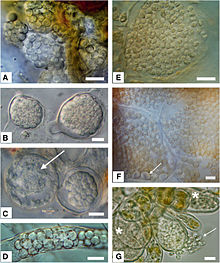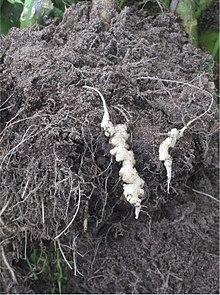Phytomyxea
| Phytomyxea | |
|---|---|

| |
| Resting spores of different species | |
| Scientific classification | |
| Domain: | Eukaryota |
| Clade: | Diaphoretickes |
| Clade: | SAR |
| Phylum: | Endomyxa |
| Class: | Phytomyxea Cavalier-Smith, 1993 |
| Orders | |
| |
| Synonyms | |
| |


The Phytomyxea are a
sugar beets and some spinaches).[3]
Life cycle
They typically develop within plant cells, causing the infected tissue to grow into a gall or scab. Important diseases caused by phytomyxeans include
club root in cabbage and its relatives, and powdery scab in potatoes.[4] These are caused by species of Plasmodiophora and Spongospora, respectively.[5]
The vegetative form is a
plasmodium. This ultimately divides to form new spores, which are released when the host's cells burst. Both resting spores and motile zoospores, which generally have two smooth flagella
, are produced at different stages. Within the plasmodium, dividing nuclei have a distinctive cross-like appearance.
Classification
Plasmodiophoromycota. However, genetic and ultrastructural studies indicate they belong to a diverse group of protists called the Cercozoa
, are closely related to them.
- Class Phytomyxea Engler & Prantl 1897 em. Cavalier-Smith 1993
- Genus ?Pongomyxa
- Order PhagomyxidaCavalier-Smith 1993
- Family PhagomyxidaeCavalier-Smith 1993
- Genus Phagomyxa Karling 1944
- Family
- Order PlasmodiophoridaCook 1928 em. Cavalier-Smith 1993
- Family Endemosarcidae Olive & Erdos 1971
- Genus Endemosarca Olive & Erdos 1971
- Family PlasmodiophoridaeBerl 1888 (plasmodial slime moulds)
- Genus Cystospora Elliott 1916 nomen dubium [Acrocystis Ellis & Halsted ex Halsted 1890 non Zanardini 1872]
- Genus Maullinia Maier et al. 2000
- Genus Phytomyxa Schröter 1886
- Genus Rhizomyxa Borzí 1884; SorolpidiumNěmec 1911]
- Genus Membranosporus Ostenfeld & Petersen 1930
- Genus Octomyxa Couch, Leitner & Whiffen 1939
- Genus Frankiella Maire & Tison 1909 non Speschnew 1900; Frankia Brunchorst 1886 non; OstenfeldiellaFerdinandsen & Winge 1914]
- Genus Polymyxa Ledingham 1933
- Genus Sorodiscus Lagerheim & Winge 1913 non Allman 1847
- Genus Sorosphaera Schröter 1886
- Genus Sorosphaerula Neuh. & Kirchm. 2011
- Genus Spongospora Brunchorst 1887 [ClathrosorusFerdinandsen & Winge 1920]
- Genus Sporomyxa Léger 1908
- Genus MolliardiaMaire & Tison 1911]
- Genus Woronina Cornu 1872
- Family Endemosarcidae Olive & Erdos 1971
References
Wikispecies has information related to Phytomyxea.
